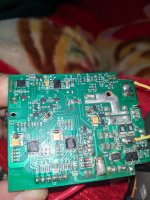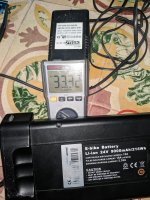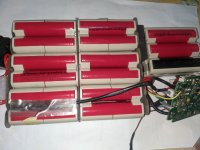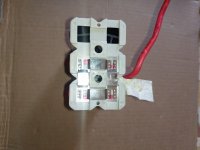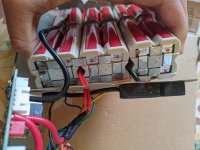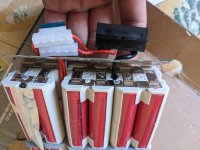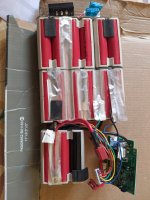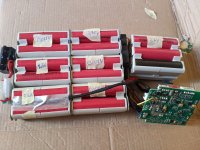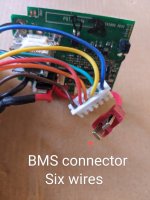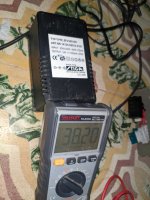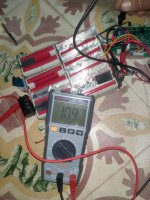I plugged the charger which labeled 24V to the ebike battery but no response on the LED when I disassembled it, I found the BMS as shown in the picture after I did the charger test the output was 33V could we say I screwed my battery ?
You are using an out of date browser. It may not display this or other websites correctly.
You should upgrade or use an alternative browser.
You should upgrade or use an alternative browser.
Wrong charger voltage BMS gone ?
- Thread starter caputcha
- Start date
Chalo
100 TW
I don't know what pack architecture you're dealing with, but no pack I've ever seen charges at 24.0 volts. Most so-called 24V packs charge at about 29V. 33.X volts would be normal full charge for an 8S lithium ion pack.
What you you know about your battery?
What you you know about your battery?
I think it's 5s pack battery, I'm newbie, correct me if I'm wrong by the way is it normal charger give 33V even it's 24V after testing the battery voltage 12 of 28 cells seems to be bad what could be the problem the charger, the BMS or faulty cells any idea ?I don't know what pack architecture you're dealing with, but no pack I've ever seen charges at 24.0 volts. Most so-called 24V packs charge at about 29V. 33.X volts would be normal full charge for an 8S lithium ion pack.
What you you know about your battery?
Attachments
Did the battery and charger ever work correctly for you? If so, what happened between the time they worked and the time they did not?
Did the charger come with the battery? If it did, then it isn't working correctly if that is actually a 5s pack. Can you show the connections that indicate it is a 5s pack?
A 5s battery is not 24v. If it's Lithium Ion it's only 5 x 4.2v max, or 21v full charge, and called an "18v" battery because it's 18.5v at nominal 5 x 3.7v.
In the picture that shows the cells, it doesn't look like a 5s, it looks like a 7s2p as there are seven visible blocks of two cells, with one block having a black placeholder instead of a third cell. If that's not correct please post how many total cells there are; it may help figure the pack out.
If it is 7s, then that's 7 x 4.2v max, or 29.4v full, and 25.9v average (close enough to call it "24v"). If the BMS works correctly the pack would never overcharge, but it's not typical to use a too-high-voltage charger for a battery pack, because if the BMS fails to turn off when the cells are full voltage, then they'll overcharge. In this case, the 33.3v - 29.4v is 3.9v, divide that across 7 cells and you get an extra half a volt on each cell, letting them overcharge to over 4.7v each, which is generally bad.
If you measure DC Volts of each of the parallel sets of cells from positive to negative, starting at the one that the main battery negative comes out of, and post those voltages here, it will help us help you figure out what the pack is and what might be wrong with it. If it's a 7s there will be seven voltage readings.
Also measure and post the votlage from the main battery positive wire (usualy red) to each of the two thick black wires that come off the BMS. One of those will go to the cells, and one will go to the battery case connector..
Did the charger come with the battery? If it did, then it isn't working correctly if that is actually a 5s pack. Can you show the connections that indicate it is a 5s pack?
A 5s battery is not 24v. If it's Lithium Ion it's only 5 x 4.2v max, or 21v full charge, and called an "18v" battery because it's 18.5v at nominal 5 x 3.7v.
In the picture that shows the cells, it doesn't look like a 5s, it looks like a 7s2p as there are seven visible blocks of two cells, with one block having a black placeholder instead of a third cell. If that's not correct please post how many total cells there are; it may help figure the pack out.
If it is 7s, then that's 7 x 4.2v max, or 29.4v full, and 25.9v average (close enough to call it "24v"). If the BMS works correctly the pack would never overcharge, but it's not typical to use a too-high-voltage charger for a battery pack, because if the BMS fails to turn off when the cells are full voltage, then they'll overcharge. In this case, the 33.3v - 29.4v is 3.9v, divide that across 7 cells and you get an extra half a volt on each cell, letting them overcharge to over 4.7v each, which is generally bad.
If you measure DC Volts of each of the parallel sets of cells from positive to negative, starting at the one that the main battery negative comes out of, and post those voltages here, it will help us help you figure out what the pack is and what might be wrong with it. If it's a 7s there will be seven voltage readings.
Also measure and post the votlage from the main battery positive wire (usualy red) to each of the two thick black wires that come off the BMS. One of those will go to the cells, and one will go to the battery case connector..
In fact, the charger come with the ebike it was working before correctly what happened it stopped working due to cycles of charging for unknown reasons.Did the battery and charger ever work correctly for you? If so, what happened between the time they worked and the time they did not?
Did the charger come with the battery? If it did, then it isn't working correctly if that is actually a 5s pack. Can you show the connections that indicate it is a 5s pack?
A 5s battery is not 24v. If it's Lithium Ion it's only 5 x 4.2v max, or 21v full charge, and called an "18v" battery because it's 18.5v at nominal 5 x 3.7v.
In the picture that shows the cells, it doesn't look like a 5s, it looks like a 7s2p as there are seven visible blocks of two cells, with one block having a black placeholder instead of a third cell. If that's not correct please post how many total cells there are; it may help figure the pack out.
If it is 7s, then that's 7 x 4.2v max, or 29.4v full, and 25.9v average (close enough to call it "24v"). If the BMS works correctly the pack would never overcharge, but it's not typical to use a too-high-voltage charger for a battery pack, because if the BMS fails to turn off when the cells are full voltage, then they'll overcharge. In this case, the 33.3v - 29.4v is 3.9v, divide that across 7 cells and you get an extra half a volt on each cell, letting them overcharge to over 4.7v each, which is generally bad.
If you measure DC Volts of each of the parallel sets of cells from po sitive to negative, starting at the one that the main battery negative comes out of, and post those voltages here, it will help us help you figure out what the pack is and what might be wrong with it. If it's a 7s there will be seven voltage readings.
Also measure and post the votlage from the main battery positive wire (usualy red) to each of the two thick black wires that come off the BMS. One of those will go to the cells, and one will go to the battery case connector..
For the architecture of the pack, it's difficult for me to determine exactly which pack is I attached clear picture of wiring,
the total cells are 28 INR18650A220.
| Brand: | YikLik (YLE) |
| Model: | INR18650A220 |
| Capacity: | 2200mAh Rated |
| Voltage: | 3.60V Nominal |
| Charging: | 4.20V Maximum 4400mA Standard 2200mA Maximum |
| Discharging: | 3.00V Cutoff 440mA Standard 2200mA Maximum |
| Description: | Red Cell Wrapper Black Insulator Ring 18650 Form Factor |
the measurement are on the sticker of each pack and voltage of main positive B+ battery to each black B- P- are null 0.005V
Attachments
docw009
1 MW
The top view suggests 7S. The side view looks like a 4P battery to me. Charger should be 29,.4V for 7P, but open circuit is sometimes higher, but never 3 volts higher. Tell us what the fine print on the charger label says.
You will see a black lead going to P- on the circuit card? Find the red lead on the battery output. Can you safely put your voltmeter probes on the red lead and P-. That will be the actual battery voltage before it goes to thru the BMS in the circuit card, Check your two fuses first.
You will see a black lead going to P- on the circuit card? Find the red lead on the battery output. Can you safely put your voltmeter probes on the red lead and P-. That will be the actual battery voltage before it goes to thru the BMS in the circuit card, Check your two fuses first.
I'd guess from the new images that it's 7s 4p, so the stuff about 7s in my previous post would still apply (you just have more cells in parallel for higher capacity).

There are only three groups of cells that are still functioning. The other four are dead and damaged and would need to be replaced.
Because the still-working groups are not all the same voltage, they are different characteristics (resistance and capacity) and if you just replace the four dead groups, you're going to have only the total capacity and capabiliyt of the worst group left there.
Realistically, to make the pack work correctly, you'd need to replace all the cells with new ones to repair the pack. It's going to be a lot easier to buy a new battery if they're still available from the manufacturer.
The charger being one cell voltage too high for this pack (assuming the pack is wired as 7s rather than 8s) isn't directly a problem unless the BMS fails or has failed so that hte charge port is stuck on so that it couldn't prevent overcharge of the pack.
If you mean on this image,the measurement are on the sticker of each pack

There are only three groups of cells that are still functioning. The other four are dead and damaged and would need to be replaced.
Because the still-working groups are not all the same voltage, they are different characteristics (resistance and capacity) and if you just replace the four dead groups, you're going to have only the total capacity and capabiliyt of the worst group left there.
Realistically, to make the pack work correctly, you'd need to replace all the cells with new ones to repair the pack. It's going to be a lot easier to buy a new battery if they're still available from the manufacturer.
B- to B+ at that low a voltage would mean that you have zero volts, that all cells are completely dead. Since you still have some groups that aren't dead and destroyed, then there is some problem with connection between the packs as well, perhaps a blown fuse or broken wire.and voltage of main positive B+ battery to each black B- P- are null 0.005V
The charger being one cell voltage too high for this pack (assuming the pack is wired as 7s rather than 8s) isn't directly a problem unless the BMS fails or has failed so that hte charge port is stuck on so that it couldn't prevent overcharge of the pack.
Yes, it's 7S 4P this charger is weirdo Yesterday when tested it was 33V, right now 38 the charger labeled 24V the value of actual battery voltage is 10.97V the two fuses checked are okThe top view suggests 7S. The side view looks like a 4P battery to me. Charger should be 29,.4V for 7P, but open circuit is sometimes higher, but never 3 volts higher. Tell us what the fine print on the charger label says.
You will see a black lead going to P- on the circuit card? Find the red lead on the battery output. Can you safely put your voltmeter probes on the red lead and P-. That will be the actual battery voltage before it goes to thru the BMS in the circuit card, Check your two fuses first.
Attachments
How to check the BMS if still functioning or gone ? If I replace the faulty ones with new one from another brand and balancing altogether assuming the BMS is still working, what the consequences could be ?I'd guess from the new images that it's 7s 4p, so the stuff about 7s in my previous post would still apply (you just have more cells in parallel for higher capacity).
If you mean on this image,
View attachment 343218
There are only three groups of cells that are still functioning. The other four are dead and damaged and would need to be replaced.
Because the still-working groups are not all the same voltage, they are different characteristics (resistance and capacity) and if you just replace the four dead groups, you're going to have only the total capacity and capabiliyt of the worst group left there.
Realistically, to make the pack work correctly, you'd need to replace all the cells with new ones to repair the pack. It's going to be a lot easier to buy a new battery if they're still available from the manufacturer.
B- to B+ at that low a voltage would mean that you have zero volts, that all cells are completely dead. Since you still have some groups that aren't dead and destroyed, then there is some problem with connection between the packs as well, perhaps a blown fuse or broken wire.
The charger being one cell voltage too high for this pack (assuming the pack is wired as 7s rather than 8s) isn't directly a problem unless the BMS fails or has failed so that hte charge port is stuck on so that it couldn't prevent overcharge of the pack.
this charger is weirdo Yesterday when tested it was 33V, right now 38
You might want to check your multimeter battery--if it's low the voltage will read high. If you're not sure just change it for a new one; they're usually the block shaped 9v batteries.
The charger should read, for a 7s battery, about 30v. (29.4v).
If the fuses are ok, but you still read basically 0v between the wires coming from the cells (B+ and B-), there's something wrong with the connection to the cells from one of those points.the value of actual battery voltage is 10.97V the two fuses checked are ok
If the BMS is between where you measure and the cells, then it's normal to not read a voltage there, because the BMS will have turned off both charge and discharge ports (C- and P-, if separate, just P- if common). because of the dead cells.
Hard to test without working cells, because it will keep it's output and input turned off until all the cells are above LVC and below HVC.How to check the BMS if still functioning or gone ?
If I replace the faulty ones with new one from another brand and balancing altogether assuming the BMS is still working, what the consequences could be ?
If you replace *only* the faulty ones, then the first thing you'll have to do is leave the whole thing on the charger long enough for the BMS to rebalance all of the cells to the same voltage, assuming it is a balancing BMS (not all of them are, and I don't see the usual passive balancing parts on there, but it could be an active balancer. How long that will take will depend on the difference in state of charge and capacity between the lowest one and the highest. It could take hours or days.
You could manually balance all the cells, charging low ones up or discharging high ones, but you have to stay there for the whole process and keep your eye on the voltmeter the entire time to make sure they dont' go above or belwo whatever voltage they should end at. It's easier to let the BMS do it.
After that, then you can use the pack normally. It will have no more capacity or runtime than whatever the worst original cell group still in the pack is, so it might not work much if any better than it did before it died.
If you replace *all* the cells at the same time with brand-new well-matched cells (that have identical resistances and capacities) of the same model cell as the originals, then you would just charge it up and use it and it will then work the same way it did when it was brand new.
Replacing the cells means needing a spot welder and nickel strip, or buying cells that are already welded together in the correct physical configuration for the groups, in compatible cell holders that will fit back in your battery case (or sending your modules to someone that can take the old cells out and replace them with new ones). If doing it yourself, Kweld seems to be a good one; there's a big thread on that and how people use it for different things.
Eastwood
100 kW
- Joined
- Jan 13, 2021
- Messages
- 1,479
Yes, it's 7S 4P this charger is weirdo Yesterday when tested it was 33V, right now 38 the charger labeled 24V the value of actual battery voltage is 10.97V the two fuses checked are ok
This is not good, this is how fires are started. It seems that the voltage pot has gone bad in your charger and you definitely do not want to try to charge that 7S pack with 33 or 38v. I would first be finding a different charger and then addressing the other issues. your charger should not go past 29.4v max.
To me it sounds like your BMS just saved you. If you would’ve charge that battery with that charger could have easily went into thermal runaway.
You might want to check your multimeter battery--if it's low the voltage will read high. If you're not sure just change it for a new one; they're usually the block shaped 9v batteries.
The charger should read, for a 7s battery, about 30v. (29.4v).
If the fuses are ok, but you still read basically 0v between the wires coming from the cells (B+ and B-), there's something wrong with the connection to the cells from one of those points.
If the BMS is between where you measure and the cells, then it's normal to not read a voltage there, because the BMS will have turned off both charge and discharge ports (C- and P-, if separate, just P- if common). because of the dead cells.
Hard to test without working cells, because it will keep it's output and input turned off until all the cells are above LVC and below HVC.
If you replace *only* the faulty ones, then the first thing you'll have to do is leave the whole thing on the charger long enough for the BMS to rebalance all of the cells to the same voltage, assuming it is a balancing BMS (not all of them are, and I don't see the usual passive balancing parts on there, but it could be an active balancer. How long that will take will depend on the difference in state of charge and capacity between the lowest one and the highest. It could take hours or days.
You could manually balance all the cells, charging low ones up or discharging high ones, but you have to stay there for the whole process and keep your eye on the voltmeter the entire time to make sure they dont' go above or belwo whatever voltage they should end at. It's easier to let the BMS do it.
After that, then you can use the pack normally. It will have no more capacity or runtime than whatever the worst original cell group still in the pack is, so it might not work much if any better than it did before it died.
If you replace *all* the cells at the same time with brand-new well-matched cells (that have identical resistances and capacities) of the same model cell as the originals, then you would just charge it up and use it and it will then work the same way it did when it was brand new.
Replacing the cells means needing a spot welder and nickel strip, or buying cells that are already welded together in the correct physical configuration for the groups, in compatible cell holders that will fit back in your battery case (or sending your modules to someone that can take the old cells out and replace them with new ones). If doing it yourself, Kweld seems to be a good one; there's a big thread on that and how people use it for different things.
This reply full of useful instructions, I will take them into consideration in further repair thanks broYou might want to check your multimeter battery--if it's low the voltage will read high. If you're not sure just change it for a new one; they're usually the block shaped 9v batteries.
The charger should read, for a 7s battery, about 30v. (29.4v).
If the fuses are ok, but you still read basically 0v between the wires coming from the cells (B+ and B-), there's something wrong with the connection to the cells from one of those points.
If the BMS is between where you measure and the cells, then it's normal to not read a voltage there, because the BMS will have turned off both charge and discharge ports (C- and P-, if separate, just P- if common). because of the dead cells.
Hard to test without working cells, because it will keep it's output and input turned off until all the cells are above LVC and below HVC.
If you replace *only* the faulty ones, then the first thing you'll have to do is leave the whole thing on the charger long enough for the BMS to rebalance all of the cells to the same voltage, assuming it is a balancing BMS (not all of them are, and I don't see the usual passive balancing parts on there, but it could be an active balancer. How long that will take will depend on the difference in state of charge and capacity between the lowest one and the highest. It could take hours or days.
You could manually balance all the cells, charging low ones up or discharging high ones, but you have to stay there for the whole process and keep your eye on the voltmeter the entire time to make sure they dont' go above or belwo whatever voltage they should end at. It's easier to let the BMS do it.
After that, then you can use the pack normally. It will have no more capacity or runtime than whatever the worst original cell group still in the pack is, so it might not work much if any better than it did before it died.
If you replace *all* the cells at the same time with brand-new well-matched cells (that have identical resistances and capacities) of the same model cell as the originals, then you would just charge it up and use it and it will then work the same way it did when it was brand new.
Replacing the cells means needing a spot welder and nickel strip, or buying cells that are already welded together in the correct physical configuration for the groups, in compatible cell holders that will fit back in your battery case (or sending your modules to someone that can take the old cells out and replace them with new ones). If doing it yourself, Kweld seems to be a good one; there's a big thread on that and how people use it for different things.
Yeah! I let the charger aside its risky unit, I will look for one working and test the suggestions which posted here thanks for the helpThis is not good, this is how fires are started. It seems that the voltage pot has gone bad in your charger and you definitely do not want to try to charge that 7S pack with 33 or 38v. I would first be finding a different charger and then addressing the other issues. your charger should not go past 29.4v max.
To me it sounds like your BMS just saved you. If you would’ve charge that battery with that charger could have easily went into thermal runaway.
docw009
1 MW
I did not realize you had already measured all the groups. Normal operating voltage of a lithium cell is 3.0V to 4.2V, The typical BMS shuts off the battery if any group is below 3V, That's why you have no power at the output.
Most cell manufacturers limit the lower operating voltage of their cells to 2,5V, There is very little power at this level, but the cell may have enough energy to power lower current devices, and it will still go into thermal runaway (fire) if it is heated past 160C, More importantly though. if a cell gets down close to zero, the same levels you have of four of your groups,. the internal chemistry degrades and it may catch on fire if you recharge it. In my opinion, the battery is unsafe and should be disposed of safely,
If the battery is one-of-a-kind where you live, and not easily replaced, then a battery expert might replace all 28 cells with new ones.
Most cell manufacturers limit the lower operating voltage of their cells to 2,5V, There is very little power at this level, but the cell may have enough energy to power lower current devices, and it will still go into thermal runaway (fire) if it is heated past 160C, More importantly though. if a cell gets down close to zero, the same levels you have of four of your groups,. the internal chemistry degrades and it may catch on fire if you recharge it. In my opinion, the battery is unsafe and should be disposed of safely,
If the battery is one-of-a-kind where you live, and not easily replaced, then a battery expert might replace all 28 cells with new ones.
''I did not realize you had already measured all the groups. Normal operating voltage of a lithium cell is 3.0V to 4.2V, The typical BMS shuts off the battery if any group is below 3V, That's why you have no power at the output.''I did not realize you had already measured all the groups. Normal operating voltage of a lithium cell is 3.0V to 4.2V, The typical BMS shuts off the battery if any group is below 3V, That's why you have no power at the output.
Most cell manufacturers limit the lower operating voltage of their cells to 2,5V, There is very little power at this level, but the cell may have enough energy to power lower current devices, and it will still go into thermal runaway (fire) if it is heated past 160C, More importantly though. if a cell gets down close to zero, the same levels you have of four of your groups,. the internal chemistry degrades and it may catch on fire if you recharge it. In my opinion, the battery is unsafe and should be disposed of safely,
If the battery is one-of-a-kind where you live, and not easily replaced, then a battery expert might replace all 28 cells with new ones.
what did you mean about the BMS shut off the battery?
when I measure the output of the battery is near 11V is equal of total voltage of working group (3 ones)
Similar threads
- Question
- Replies
- 4
- Views
- 578


